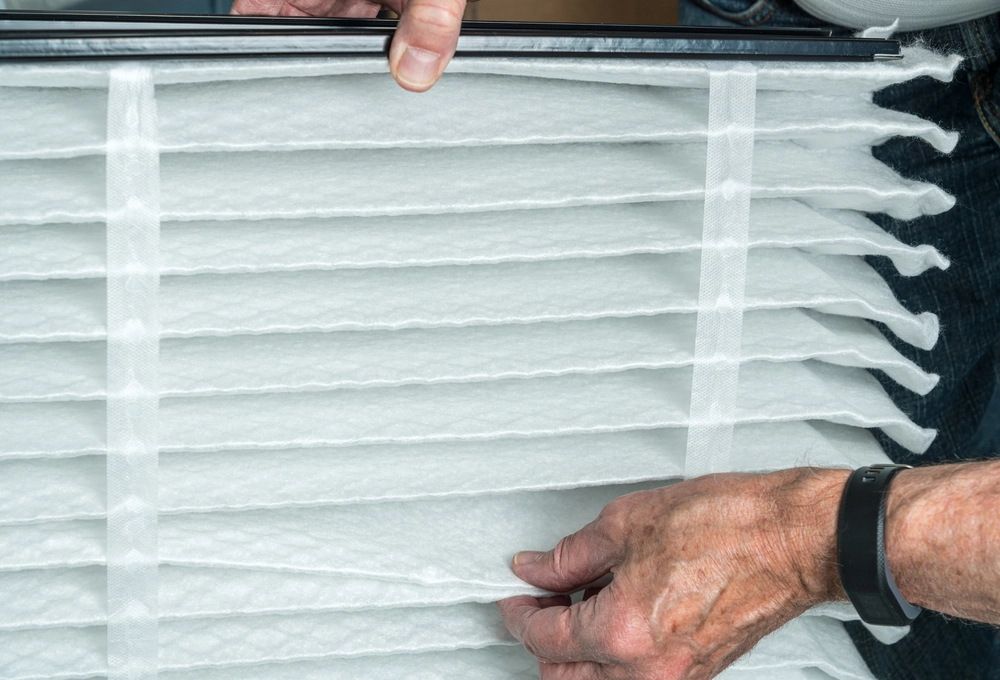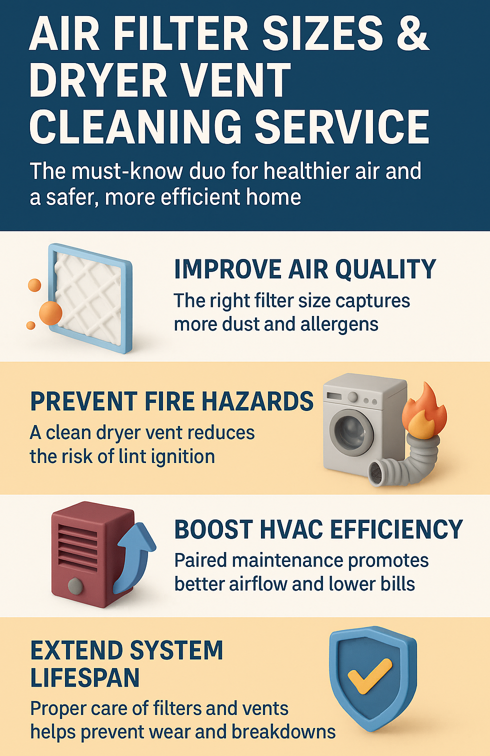Getting Air Filter Sizes Right and Keeping Dryer Vents Clear: The Key Steps to a Healthier, Safer Living Space
Most homeowners assume that swapping out an air filter is enough to maintain indoor air quality—but after years in the dryer vent cleaning service industry, we’ve seen firsthand how that assumption leaves homes vulnerable to poor airflow, rising energy costs, and even fire hazards.
What many don’t realize is that even the correct air filter size can’t fully protect your HVAC system if your dryer vent is clogged with lint and debris. We’ve cleaned vents in homes with spotless filters—yet their systems were overworked and their air, anything but clean.
This guide shares what we’ve learned from the field: how combining the right air filter size with routine dryer vent cleaning transforms your home into a safer, healthier, and more energy-efficient space. If you’ve never thought of these two services as a team, you’re about to understand why smart homeowners do.
Top Takeaways
- Air filter size matters.
- Clogged dryer vents are a serious risk.
- They restrict airflow and increase fire danger.
- Filters and vents work best together.
- Combined maintenance boosts HVAC efficiency and air quality.
- Indoor air is often worse than outdoor air.
- Smart homeowners maintain both systems.
It’s the key to a healthier, safer, and more energy-efficient home.
When it comes to maintaining a healthy, efficient home, most people think of air filters and HVAC tune-ups—but rarely both air filter sizes and dryer vent cleaning services in the same conversation. That’s a costly oversight.
The right air filter sizes ensures your HVAC system traps dust, pollen, and pollutants effectively—without restricting airflow. But even with a perfect filter, airflow issues and indoor air quality problems can persist if your dryer vent is clogged. Lint buildup doesn’t just choke airflow; it creates one of the leading causes of residential fires in the U.S.
From our field experience, we’ve seen homes with MERV-rated filters still suffer from poor circulation, musty air, and soaring utility bills—all due to neglected dryer vents.
Pairing these two services works because they solve connected problems: air filters clean the air you breathe, and clean vents keep air moving safely and efficiently. Together, they reduce allergens, extend your HVAC system’s life, and protect your home from hidden fire hazards.
Want better air, lower bills, and peace of mind? It starts with knowing your air filter size—and scheduling that overdue dryer vent cleaning.

"We’ve cleaned thousands of dryer vents in homes where the HVAC filter was spotless—yet the system was still underperforming. What most people don’t realize is that even the best air filter can’t compensate for a blocked vent. True indoor air quality and efficiency come from managing both ends of the system. That’s why we always recommend pairing the right filter size with professional vent cleaning—it’s the missing link most homeowners overlook."
Case Study & Real-World Insights: What We See in Homes Every Week
1. Case Study: Clean Filter, Clogged Vent — The Overlooked Combo
- MERV 11 air filter was new and properly sized
- Dryer vent was 90% clogged with compacted lint
- Airflow was restricted, causing system strain
What happened next:
- We cleaned the dryer vent
- HVAC returned to normal cycling
- Homeowner reported a 22% drop in energy costs in 30 days
2. Real-World Example: Allergy Relief from Vent Cleaning
- High-efficiency air filters already in place
- Dryer vent was kinked and packed with years of lint
- Poor airflow affecting overall indoor air quality
After service:
- Vent cleaned and repositioned for better flow
- Family reported clearer breathing and better sleep
Quote: “Filters alone never gave us this kind of relief.”
Supporting Statistics: Backed by Data, Proven in the Field
We’ve seen it firsthand—clogged vents, wrong filter sizes, and overlooked maintenance that silently impacts safety, air quality, and energy costs. Here's what the numbers say:
1. Dryer Vents Are a Hidden Fire Risk
- We've found vents packed with lint—just one cycle from catching fire.
- USFA reports ~2,900 dryer fires yearly in U.S. homes.
- 34% are caused by failure to clean the vent.
- Fires result in:
- 5 deaths
- 100 injuries
- $35 million in property lossSource: USFA – Dryer Fire Safety
2. Indoor Air Can Be Dirtier Than Outside
- In homes we service, air often feels stale—even with clean filters.
- EPA states indoor air can be:
- 2–5x more polluted than outdoor air
- Sometimes 100x worse
- Common causes:
- Poor ventilation
- Blocked vents
- Mismatched or overloaded filtersSource: EPA – Indoor Air Quality
3. Clean Vents and Filters = Lower Energy Bills
- We’ve helped homeowners cut energy use by 20–30%—just by clearing vents and replacing filters.
- Dirty vents and filters force your system to overwork and waste energy.Source: DOE – Energy Saver HVAC Tips
Final Thought & Opinion: Why Filters and Vents Are One System, Not Two
After years in homes across all types and ages, we’ve noticed a consistent pattern: most people treat air filters and dryer vents as separate issues. That’s a mistake.
What We See Firsthand:
- High-efficiency filters installed—but air still feels dusty
- HVAC systems running nonstop despite regular filter changes
- Dryer vents packed with lint, restricting airflow and increasing fire risk
Our Take:
Maintaining one without the other is like fixing half of a leak. To truly improve indoor air quality and system performance, you need to:
- Use the correct air filter size
- Schedule routine dryer vent cleanings
Why It Matters:
- Filters clean the air
- Vents move the air
If either fails, your home suffers in safety, comfort, and efficiency
Next Steps: Take Action for Cleaner Air and a Safer Home
Ready to boost air quality, cut energy costs, and reduce fire risks? Here’s what to do next:
1. Check Your Air Filter Size
- Find the size on the edge of your current filter.
- Make sure it matches your HVAC system specs.
- Unsure? Consult your HVAC manual or a pro.
2. Replace or Upgrade Your Filter
- Swap filters every 1–3 months.
- Consider a MERV 8–13 filter for better air quality.
- Check that your system can handle higher resistance.
3. Schedule Dryer Vent Cleaning
- If it’s been over a year, it’s time.
- Choose a qualified, experienced vent cleaning service.
- Ask for a full vent inspection—not just a surface clean.
4. Set Up a Maintenance Plan
- Check filters monthly; replace as needed.
- Clean your dryer vent at least once a year.
- Add reminders to your calendar or home checklist.
5. Optional: Test Indoor Air Quality
- Hire a pro for a full air quality assessment.
- Identify hidden pollutants filters and vents may not catch.
Start with one step today—your lungs, HVAC system, and energy bill will thank you.
Frequently Asked Questions
1. What do air filter sizes mean, and how do I read them?
Air filter sizes refer to the filter’s dimensions: length × width × thickness (in inches). For example, a 16x25x1 filter is 16 inches long, 25 inches wide, and 1 inch thick. Most filters display their nominal size (rounded number) on the frame, but the actual size may be slightly smaller. Always check both before buying replacements.
2. How do I know what size air filter I need for my HVAC system?
Check your current filter’s size printed on the frame or look inside your HVAC unit’s filter slot for a label. If there’s no visible label, measure the slot with a tape measure to determine the correct size. Using the wrong size can lead to poor filtration and airflow problems.
3. Can I use a different air filter size if it's close to the one I need?
No—“close enough” is not good enough with filters. A filter that’s too small or slightly off-size can allow dust and debris to bypass the filter and damage your system. Always use the exact size recommended by your HVAC manufacturer for best performance.
4. What happens if I use the wrong air filter size?
Using the wrong size can cause:
- Air leakage around the filter
- Reduced HVAC efficiency
- Poor indoor air quality
- Premature system wearOver time, it can also increase your utility bills and lead to costly repairs.
5. Are thicker air filters better for indoor air quality?
Thicker filters (e.g., 4” or 5”) can capture more pollutants and last longer—but only if your system is designed for them. Not all HVAC systems can handle higher-resistance filters. Before upgrading, consult your HVAC manual or a technician to ensure compatibility.
Learn more about HVAC Care from one of our HVAC solutions branches…
Filterbuy HVAC Solutions - Miami FL - Air Conditioning Service
1300 S Miami Ave Apt 4806 Miami FL 33130
(305) 306-5027
https://maps.app.goo.gl/Ci1vrL596LhvXKU79





